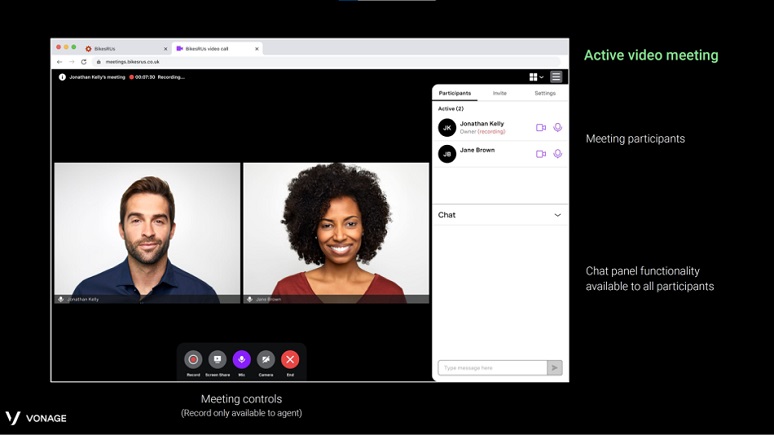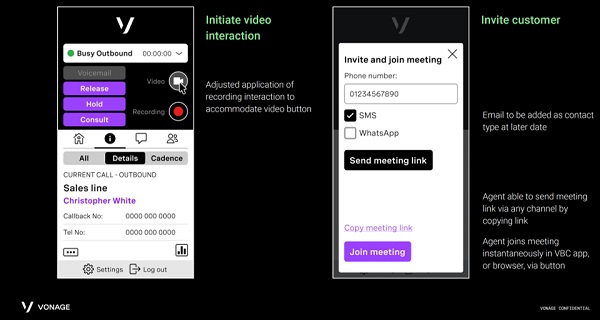Spring is a traditional time of renewal. In keeping with that theme, in the space of two or three weeks we typically see cloud communications software vendors reveal their Spring application updates — an opportunity to showcase especially notable new capabilities that have become available in the continuous release cycle that characterizes the cloud model. Today Vonage takes center stage with the
announcement of newly available visual engagement, AI, and omnichannel features for Vonage Contact Center (VCC).
The new contact center capabilities are in line with the product strategy put in place by
CEO Rory Read after he assumed the leadership role in June 2020. During an analyst briefing that November, Read described the Vonage Communications Platform (VCP) as the company’s core solution for delivering CCaaS, UCaaS, and CPaaS. He explained that future functionality would be developed from APIs, embedded in UC and contact center solutions, and resold to developers and customers across the API ecosystem.
Read also promised that innovation would result from the efficient use of R&D dollars. During that same briefing,
Roland Selmer, Vonage SVP, product management, discussed 2020 product launches for its video APIs, borne out of the
TokBox business Vonage purchased in 2018. Selmer highlighted Vonage’s migration to AWS for increased elastic scaling, with a focus on video quality improvements to help with health and educational use cases, and the addition of regional zones in Europe, Latin America, and Australia to improve video performance and reduce latency.
Today’s VCC announcements show how work initially done to benefit the API business is being leveraged to create the visual engagement capability. The video quality and regional enhancements made for video APIs now help create a richer contact center offer.
The image below shows how an agent can easily invite a customer to a video chat by sending an SMS or WhatsApp message (email is set to be added in the future). Visual Engagement for Vonage Contact Center is part of ContactPad, an embeddable agent desktop app for Salesforce, Microsoft Dynamics, or ServiceNow. With a single click, agents can escalate any interaction to a video call with screen share capabilities. Using Vonage’s own video APIs, the agent and customer are joined on a call that can be recorded like any other voice or text interaction (see image above).
Seamless visual engagement is a key component of the Spring ’21 VCC release, which contains other noteworthy new features, as well. One is native webchat, which offers Vonage the opportunity to sell VCC to businesses that may have custom CRM applications or no CRM at all. Till this release, VCC users have had to depend on their CRM platform, such as Salesforce, Service Now, or Microsoft Dynamics, for their omnichannel capabilities. Vonage has also enhanced the
Vonage AI – Virtual Assistant it delivered in 2020 with a new editing tool, described as a “no-code conversation designer.”
Do other CCaaS vendors offer video contact center solutions? Certainly, they do; video chat in the contact center has been happening for years. In 2010, for example, Cisco combined premises IVR, video, and call center products (running on a host of servers) to offer a video contact center solution. In 2013, Amazon added the
Mayday video chat button to the Kindle Fire and those of us who watch the contact center market closely thought, “Is now the time for video in the contact center?” Apparently, it was not, as Amazon unceremoniously removed Mayday from the devices in 2018. More recently, in 2020
Lifesize acquired CCaaS player Serenova and promised, and later delivered, video capability in the application. Vonage’s approach of integrating the video tightly with the customer’s CRM solution will certainly appeal to the large proportion of companies whose primary agent desktop is supplied by their CRM vendor.
As noted in a
2013 No Jitter post, the prevailing sentiment has long been that consumer confidence and demonstrable ROI are holding back widespread usage of video in contact centers, despite improvements in underlying technology. But things have changed with the pandemic, and tasks beyond the niche use cases of private banking and insurance claims seem poised to be more easily solved using video chats and screen sharing between agents and customers.











